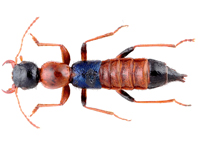Abstract
The thysanopteran genus Chiridurothrips Okajima is known from a single extant species, C. hisakoae Okajima, collected in Japan (ThripsWiki 2019). Occurring on dead leaves and branches of evergreen trees in the subtropical Ryukyu Islands, this species remains known from only five females (Okajima 1981, 2006; also pers. comm. 2018). Within Phlaeothripidae, Chiridurothrips is associated with the tribe Plectrothripini. Species of this sub-group feed on fungal hyphae or the break-down products of fungal attack on decaying plant material (Mound & Ng 2018). They are found mainly under the bark of trees or on dead branches, and they do not seem to inhabit leaf-litter (Okajima 1981). At present, Plectrothripini comprises 60 extant species in 13 genera, with no fossils recorded. Of these species 32 are placed in the genus Plectrothrips Hood, ten in Streptothrips Priesner, and six in Chirothripoides Bagnall, whereas both Menothrips Hood and Mastigothrips Priesner each include only two species. The remaining eight species are all placed in separate monobasic genera (ThripsWiki 2019). Concerning this strongly asymmetric classification, Mound and Ng (2018) suggest that Plectrothripini might be particularly old, with the large number of monobasic genera each representing a relict lineage. An alternative possibility, however, might be an unusual instability in the genes controlling morphogenetic processes, and thus resulting in striking autapomorphies on which each one of these genera is diagnosed (Mound & Ng 2018). Species associated with Plectrothripini share the following character states (Okajima 1981; Mound & Tree 2017): antennae 8-segmented, segment II with the campaniform sensillum situated in the basal half, III–IV with stout sense cones, VIII slender with narrow base; head with posterior ocelli close to compound eyes; pronotum commonly with sclerotized plate eroded or reduced, prosternal basantra week or absent; legs with fore tarsal tooth large; mid and hind tibiae commonly with apical spur-like setae; macropterae with fore wings parallel-sided, usually with duplicated cilia; pelta broad at base, abdominal tergite II eroded laterally; abdominal sternites often with reticulate glandular areas. Regarding the fore wings, it seems worth mentioning that in some members of Plectrothripini the subbasal wing vein is reduced and thus the three subbasal wing setae are lacking (see Plectrothrips tenuis Okajima, Chiridurothrips [c.f. fig. 2], Chirothripoides, Lonchothrips Hood; Bhatti 1998; Okajima 1981). This short vein that is present in (almost all) other macropterous Phlaeothripidae has been interpreted as a plesiomorphic feature that resulted from the reduction of a former well-developed longitudinal first vein of ancestral Tubulifera, the Rohrthripidae (Ulitzka 2018, 2019).
References
Arillo, A. & Ortuño, V.M. (2005) Catalogue of fossil insect species described from Dominican amber (Miocene). Stuttgarter Beiträge zur Naturkunde, Serie B (Geologie und Paläontologie), 352, 1–68.
Bhatti, J.S. (1998) New structural features in the Order Tubulifera (Insecta). 3. The tarsal hamus and thoracic appendages. Zoology (Journal of Pure and Applied Zoology) 5, 253–284.
Grimaldi, D.A. (1996) The age of Dominican amber. In: Anderson, K.B. & Crelling, J.C. (Eds.), Amber, resinite, and fossil resins. Series 617. American Chemical Society Symposium, Washington, D.C., pp. 203–217.
https://doi.org/10.1021/bk-1995-0617.ch011
Iturralde-Vincent, M.A. & MacPhee, R.D.E. (1996) Age and Paleogeographical Origin of Dominican Amber. Science, 273, 1850–1852.
https://doi.org/10.1126/science.273.5283.1850
Lambert, J.B., Frye, J.S. & Poinar Jr., G.O. (1985) Amber from the Dominican Republic: Analysis by nuclear magnetic resonance spectroscopy. Archaeometry, 27, 43–51.
https://doi.org/10.1111/j.1475-4754.1985.tb00345.x
Mound, L.A. & Ng, Y.F. (2018) Autapomorphies in the generic classification of Plectrothripini (Thysanoptera, Phlaeothripinae), with a new genus and a new record from Malaysia. Zootaxa, 4402 (2), 390–394.
https://doi.org/10.11646/zootaxa.4402.2.10
Mound, L.A. & Tree, D.J. (2017) Two new Australian fungus-feeding thrips in two new Plectrothripini genera (Thysanoptera, Phlaeothripinae). Zootaxa, 4273 (3), 443–446.
https://doi.org/10.11646/zootaxa.4273.3.10
Okajima, S. (1981) A revision of the tribe Plectrothripini of fungus-feeding Thysanoptera (Phlaeothripidae: Phlaeothripinae). Systematic Entomology, 6, 291–336.
https://doi.org/10.1111/j.1365-3113.1981.tb00441.x
Okajima, S. (2006) The Suborder Tubulifera (Thysanoptera). In: Morimoto, K. (Ed.), The Insects of Japan. Vol. 2. The Entomological Society of Japan, Touka Shobo Co. Ltd., Fukuoka, pp. 1–720.
Pérez-Gelabert, D.E. (1999) Catálogo Sistemático y Bibliografia de la Biota fósil en Ámbar de la República Dominicana. Hispaniola, Nueva Serie, 1, 1–65.
Poinar Jr., G.O. (1991) Hymenaea protera sp. n. (Leguminosae: Caesalpinoideae) from Dominican amber has African affinities. Experientia, 47, 1075–1082.
https://doi.org/10.1007/BF01923347
Poinar Jr., G.O. (2013) Palaeoecological perspectives in Dominican amber. Annales de la Société Entomologique de France, New Series, 46, 23–52.
https://doi.org/10.1080/00379271.2010.10697637
Schlee, D. (1990) Das Bernstein-Kabinett: Begleitheft zur Bernsteinausstellung im Museum am Löwentor. Stuttgarter Beiträge zur Naturkunde, Serie C, 28, 1–100.
zur Strassen, R. (1973) Fossile Fransenflügler aus mesozoischem Bernstein des Libanon (Insecta: Thysanoptera). Stuttgarter Beiträge zur Naturkunde, 256, 1–51.
The Blue Amber Blog (2006) Dominican Amber Mines: The Definitive List. Available from: https://web.archive.org/web/20080420083549/http://ambarazul.com/wordpress/2006/09/ (accessed 16 August 2019)
Thrips Wiki Contributors (2019) Thrips Wiki—providing information on the world’s thrips: Classification overview. Available from: https://thrips.info/wiki/Chiridurothrips (accessed 14 August 2019)
Ulitzka, M.R. (2015) Two new species of Aeolothripidae from Baltic Tertiary amber (Insecta: Thysanoptera). Palaeodiversity, 8, 89–94.
https://doi.org/10.13140/RG.2.1.3043.2087
Ulitzka, M.R. (2018) A first survey of Cretaceous thrips from Burmese amber including the establishment of a new family of Tubulifera (Insecta: Thysanoptera). Zootaxa, 4486 (4), 548–558.
https://doi.org/10.11646/zootaxa.4486.4.8
Ulitzka, M.R. (2019) Five new species of Rohrthrips (Thysanoptera: Rohrthripidae) from Burmese amber, and the evolution of Tubulifera wings. Zootaxa, 4585 (1), 27–40.
https://doi.org/10.11646/zootaxa.4585.1.2

